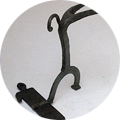"I came to France in 1973, the year in which Picasso died and the Tour Montparnasse was inaugurated." These are the landmarks of Masayoshi Yamada or simply Yamada, as known by his Japanese family name, who arrived to the French capital thanks to the Prix de Paris, given to him by the Musashino Art University in Tokyo. Yamada has not left Paris since – he went into voluntary exile in order to let his imagination run free between two different worlds and artistic traditions.
After a long stay at the Cité Internationale des arts and visiting César's studio at Ecole nationale des Beaux-Arts, Yamada settled down and opened his own studio on the Avenue de Clichy. He began by sculpting so-called "universal" heads of no apparent type or sexuality, as well as fetuses in resin polyester. Perhaps he chose sculpting as his primal focus because of his desire to sculpt and touch the earth, which in his words stems from his peasant origins; nevertheless, Yamada didn't decide to focus solely on sculpture: he wishes to remain free. "My work originates from my life, which is in constant motion" and "I came" ("Ko-n-ni-chi-wa") are words uttered by these five neutral big heads – these are one of his early works, with only the lips moving.
Yamada doesn't yet speak French well; that's why he makes his sculptures talk. He believes his "artistic approach is above all about communicating with others", as he admits even today. His fetuses are now starting to bring him international recognition: one of his fetuses carries a backpack and supports himself leaning on an umbrella (Yamada's father made frames for traditional Japanese umbrellas, made from bamboo and oily paper), others are much smaller in size and accompany him on his trips abroad.
The central matter, which occupied 17 years of his life, are collages, made from little pieces of paper that used to be posters in the metro. These are not ripped posters in the style of other artists, such as Villeglé or Rotella, but rather reused and recycled material, twisted and turned by the artist so as to make his own personal jigsaw, a paper mosaic. Sometimes, he mixes his works with others, such as The Great Wave by Hokusai or the Tomb of the Diver from the city of Paestum. Yamada plunges into dialogue between the West and Asia and the different faces of his artistic self. Always in motion, moving, shifting and travelling, Yamada really never stopped sculpting, not event during his "paper years": he returned to sculpting at the turn of the 21st century. Yamada seeks difficulty and wishes to rediscover freshness; he spontaneously decided to pierce a bathtub to let the light shine through it on the verge of 9/11.
He works with slate, iron, stone, wood, lead, Plexiglas, mirrors, glasses and other mediums. Yamada adapts the materials for his own needs and paints on them. During these last few years, we can observe the appearance of strange people in his works; some kind of four-legged creatures, made of iron frameworks, covered with goat-skin bandages, sometimes even with pieces of a kimono. Reinventing himself, Yamada continues to question the origins and the endings of Man, his fate juxtaposed between lightness and delicacy, gravity and heaviness, his footprints, the evolution of his body from the fetus. In a way, he reinterprets the riddle of the Sphinx.
Using descriptions like "discoverer" and "nomadic re-inventor", Alain Jouffroy wrote: "[Yamada] will help other individuals to realize and understand themselves as a plurality of men hidden in one body, the carriers of many long intertwined traditions, known or a secret even to themselves."


Musashino Fine Arts University
and arrives in Paris
lives in Médan and works in Paris
















